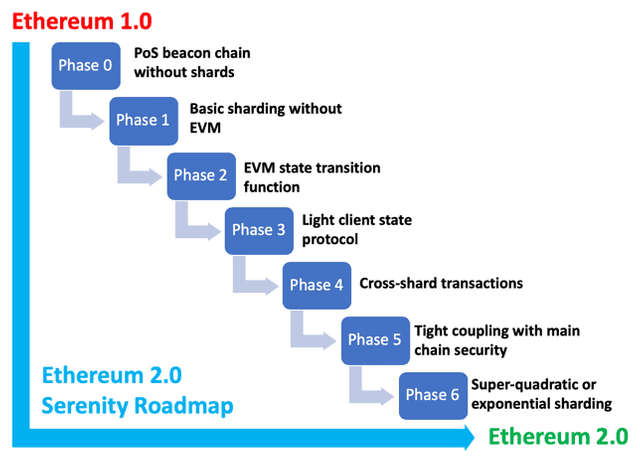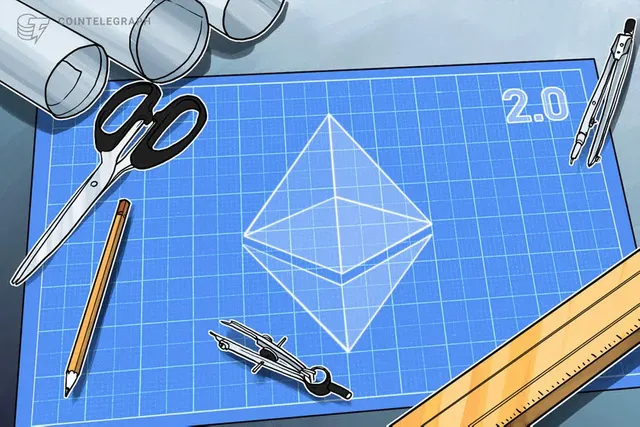Ethereum 2.0 is an upgrade to the Ethereum Network which improves the speed, efficiency, and scalability of the network.
----- This will take Ethereum to new heights as it will be able to drastically more transactions, alleviating congestion, and high gas costs on the Ethereum network.
----- Ethereum will meet her goals of becoming a transparent and open network for decentralized applications and finance (DeFi).
----- The roadmap for this upgrade.
----- including major economic changes that will come with the introduction of a new ETH 2.0 token.
------ Ethereum 2.0 will involve sharding to drastically increase network bandwidth and reduce gas costs, making it cheaper to send Ethereum, tokens, and interact with smart contracts.
---- There will be fundamental economic changes too, Ethereum 2.0 will allow supports to staking nodes and earn Ethereum as passive income.
----- Testing for Ethereum 2.0’s deployment is currently underway with the “Medalla Testnet” – a multi client test that involves the participation of 20,000+ validators worldwide. This will be the final official public test before Ethereum 2.0 Phase 0 is deploy.
----- The important Features of Ethereum 2.0 that we should look out for are
---- Sharding – Ethereum will be broken into 18 “Shards” that operate at the same time. This will drastically improve efficiency.
---- Staking – Ethereum will move to Proof-of-Stake Consensus, a much more energy efficient method of maintaining the network.
ETH2.0 will fundamentally change the current economics. In fact, the Ethereum update will completely erase the concept of mining. So my Ethereum miner will be retired once the Ethereum 2.0 update is fully completed.
Here is the detailed roadmap for Ethereum 2.0’s by [Ethereum Serenity]
Like on the 4th August 2020, the “Final” testnet for Ethereum 2.0 named “Medalla” has been deployed. Unlike the other previous testnets, this test is open to the public and will allow any of the 5 clients – Prysmatic Labs’ Prysm, ChainSafe’s Lodestar, PegaSys’ Teku, Status’ Nimbus and Sigma Prime’s Lighthouse – to connect to the network and communicate with each other. Also, since it is public, network validators are not centrally coordinated by developer teams. So far, over 30,000 validators have joined the network and over 946,000 ETH has been staked.
----The test is expected to run until the end of this year, after which
Phase 0 will officially be deployed
[
 ]
]

Ethereum 2.0 Roadmap (via Consensys)
So based on the above Ethereum 2.0 Roadmap diagram, we are working through Serenity Phase 0. Reception to the testnet has been overwhelming, with more than 20,000 validators signing up and dedicating their resources to help with the Beacon Chain Testnet. Vitalik Buterin- the Founder of Ethereum has stated that this will not be the “Final” test of the Beacon Chain, so we expect even more community participation in the months ahead.
-----Phase 1- Shard Chain and finally Phase 2- Execution Engine, as will be detailed below.
-----Phase 0 comes a new token, ETH2. Users of Ethereum will be able to convert to ETH2 (at a 1:1 ratio) via a registration contract (which effectively burns the ETH you used to hold). The community will have the option to stake 32 ETH2 on validator nodes.
Phase 1- Shard Chain
Phase 1 would allow Ethereum to scale immensely via “shards”. The network will be split into 64 shards that operate at the same time, meaning they will all be processing transactions and computation. Phase 1 will also allow the shards to communicate with each other via crosslinking.
Phrase 2 – Execution Engine
Phase 2 will bring about the final form of Ethereum 2.0. This is when the existing proof of work (legacy) and newer proof of stake network comes together.
Thanks